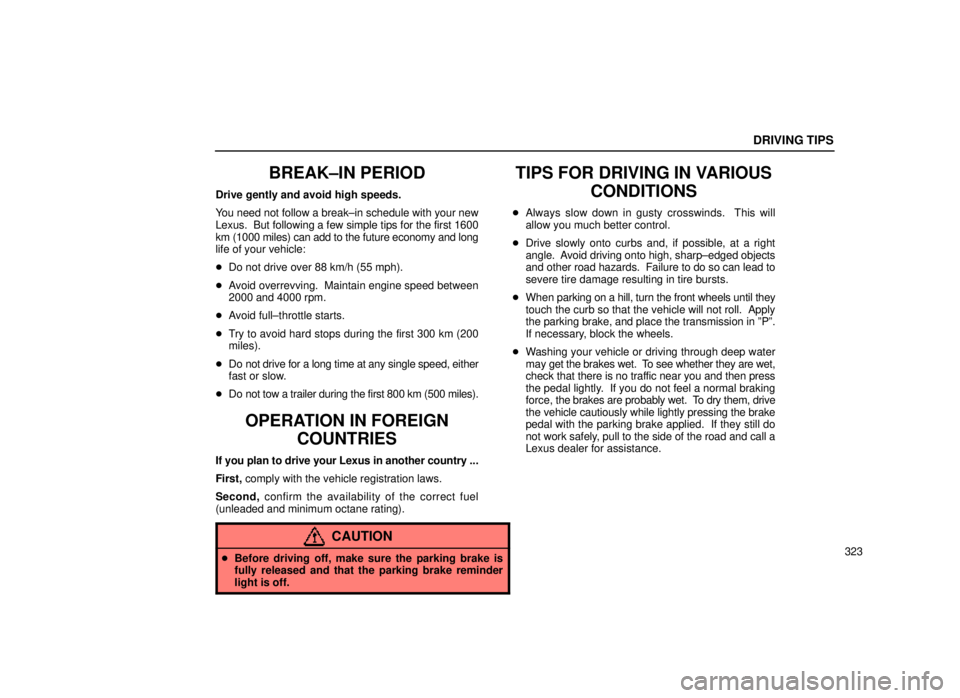Page 324 of 495
STARTING AND DRIVING
308�
Slip indicator light
If the vehicle is going to skid during driving, the slip
indicator light flashes and an alarm sounds.
The vehicle skid control activates when the vehicle
speed is about more than 15 km/h (9 mph).
Depressing the brake pedal repeatedly causes a small
noise from the engine compartment. This is a pump
pulsating sound of the brake system and it is not a
malfunction.
You may hear a sound in the engine compartment for a
few seconds when the engine is started or just after the
vehicle is started. This means that the vehicle skid
control is in the self±check mode and does not indicate
a malfunction.
31L017a
Page 327 of 495

STARTING AND DRIVING
311
After the battery terminals are disconnected, an initial
adjustment should be made. At this time, the reminder
light
comes on and the warning message appears in the
multi information display.
Make an initial adjustment in the following ways:
1. Apply the parking brake and put the transmission in
ºPº.
2. Connect the battery terminals.
3. Turn the ignition switch on. At this time, the ºVSC
OFFº indicator light comes on and then about 6 seconds
later, the reminder light comes on and the ºCHECK VSCº
warning message appears in the multi information
display.
4. The warning message and the ºVSC OFFº indicator
light go out about 15 seconds after the ignition switch is
turned on. If the vehicle is shaken after the ignition
switch is t urned to ºONº, it may take longer to go out the
warning message.
If the warning message does not go out about 1 minute
after you turn the ignition switch on, turn it off and then
on again.
If the vehicle is on the moving object like a ship or
turntable, an accurate adjustment cannot be made.
Move the vehicle on the ground (or the part not causing
vibrations to the vehicle) and make an adjustment from
step 1.
Page 329 of 495
STARTING AND DRIVING
313
BRAKE SYSTEM
The tandem master cylinder brake system is a hydraulic
system with two separate sub±systems. If either
sub±system should fail, the other will still work.
However, the pedal will be harder to press, and your
stopping distance will be longer. Also, the brake system
warning light may come on.
CAUTION
Do not drive your vehicle with only a single brake
system. Have your brakes fixed immediately.
Brake booster
The brake booster uses engine vacuum to power±assist
the brakes. If the engine should quit while you are
driving, you can bring the vehicle to a stop with normal
pedal pressure. There is enough reserve vacuum for
one or two stops but no more!
Page 334 of 495

STARTING AND DRIVING
318This light comes on when the ignition key is turned
to the ºONº position. After about a few seconds, the
light will go off.
If either of the following conditions occurs, this indicates
a malfunction somewhere in the parts monitored by the
warning light system. Contact your Lexus dealer as
soon as possible to service the vehicle.
�
The light does not come on as described above, or
remains on.
� The light comes on while driving.
Even if the anti±lock brake system should fail, the brake
system will still operate conventionally. But when the
ºABSº warning light is on (and the brake system warning
light is off), anti±lock brake system is not assisting brake
performance so that the wheels could lock up during a
sudden brake or braking on slippery road surfaces.
Have your vehicle checked by your Lexus dealer as
soon as possible.
Drum±in±disc type parking brake system
Your vehicle has a drum±in±disc type parking brake
system. This type of brake system needs
bedding±down of the brake shoes periodically or
whenever the parking brake shoes and/or drums are
replaced.
Have your Lexus dealer perform the bedding±down.
Page 339 of 495

DRIVING TIPS
323
BREAK±IN PERIOD
Drive gently and avoid high speeds.
You need not follow a break±in schedule with your new
Lexus. But following a few simple tips for the first 1600
km (1000 miles) can add to the future economy and long
life of your vehicle:
�Do not drive over 88 km/h (55 mph).
� Avoid overrevving. Maintain engine speed between
2000 and 4000 rpm.
� Avoid full±throttle starts.
� Try to avoid hard stops during the first 300 km (200
miles).
� Do not drive for a long time at any single speed, either
fast or slow.
� Do not tow a trailer during the first 800 km (500 miles).
OPERATION IN FOREIGN
COUNTRIES
If you plan to drive your Lexus in another country ...
First, comply with the vehicle registration laws.
Second, confirm the availability of the correct fuel
(unleaded and minimum octane rating).
TIPS FOR DRIVING IN VARIOUS CONDITIONS
�Always slow down in gusty crosswinds. This will
allow you much better control.
� Drive slowly onto curbs and, if possible, at a right
angle. Avoid driving onto high, sharp±edged objects
and other road hazards. Failure to do so can lead to
severe tire damage resulting in tire bursts.
� When parking on a hill, turn the front wheels until they
touch the curb so that the vehicle will not roll. Apply
the parking brake, and place the transmission in ºPº.
If necessary, block the wheels.
� Washing your vehicle or driving through deep water
may get the brakes wet. To see whether they are wet,
check that there is no traffic near you and then press
the pedal lightly. If you do not feel a normal braking
force, the brakes are probably wet. To dry them, drive
the vehicle cautiously while lightly pressing the brake
pedal with the parking brake applied. If they still do
not work safely, pull to the side of the road and call a
Lexus dealer for assistance.
CAUTION
� Before driving off, make sure the parking brake is
fully released and that the parking brake reminder
light is off.
Page 353 of 495

DRIVING TIPS
337
�
Avoid unnecessary stopping and braking.
Maintain a steady pace. Try to time the traffic si gnals
so you only need to stop as little as possible or take
advantage of through streets to avoid traffic lights.
Keep a proper distance from other vehicles to avoid
sudden braking. This will also reduce wear on your
brakes.
� Avoid heavy traffic or traffic jams whenever
possible.
� Do not rest your foot on the brake pedal. This
causes needless wear, overheating and poor fuel
economy.
� Maintain a moderate speed on highways. The
faster you drive, the greater the fuel consumption. By
reducing your speed, you will cut down on fuel
consumption.
� Keep the front wheels in proper alignment. Avoid
hitting the curb and slow down on rough roads.
Improper alignment not only causes faster tire wear
but also puts an extra load on the engine, which, in
turn, wastes fuel.
� Keep the bottom of your vehicle free from mud,
etc. This not only lessens weight but also helps
prevent corrosion.
� Keep your vehicle tuned±up and in top shape. A
dirty air cleaner, improper valve clearance, dirty
plugs, dirty oil and grease, brakes not adjusted, etc.
all lower engine performance and contribute to poor
Page 398 of 495

MAINTENANCE
382
Vehicle interior
Items listed below should be checked regularly, e.g.
while performing periodic services, cleaning the
vehicle, etc.
Lights
Make sure the headlights, stop lights, tail lights, turn
signal lights, and other lights are working. Check
headlight aim.
Service reminder indicators and warning buzzers
Check that all service reminder indicators and warning
buzzers function properly. Steering wheel
Check that it has the specified freeplay. Be alert for
changes in steering condition, such as hard steering,
excessive freeplay or strange noise.
Seats
Check
that all front seat controls such as seat adjusters,
seatback recliner, etc. operate smoothly. Check that the
head restraints move up and down smoothly and that the
locks hold securely in any latched position.
Seat belts
Check that the seat belt system such as buckles,
retractors and anchors operate properly and smoothly.
Make sure the belt webbing is not cut, frayed, worn or
damaged.
Accelerator pedal
Check the pedal for smooth operation and uneven pedal
effort or catching.
Brake pedal
Check the pedal for smooth operation and the proper
clearance and freeplay. Check the brake booster
function.
Brakes
At a safe place, check that the brakes do not pull to one
side when applied.
Page 433 of 495
CHASSIS
417
CHECKING BRAKE FLUID
63L001a
To check the fluid level, simply look at the
see±through reservoir. The level should be between
the ºMAXº and ºMINº lines on the tank.
It is normal for the brake fluid level to go down slightly as
the brake pads wear. So be sure to keep the reservoir
filled.
If the reservoir needs frequent refilling, it may indicate a
serious mechanical problem.
If the level is low, add FMVSS No.116 DOT 3 or SAE
J1703 brake fluid to the brake reservoir.
Remove and replace the reservoir cover by hand. Add
brake fluid up to the ºMAXº line.
Use only newly opened brake fluid. Once opened, brake
fluid absorbs moisture from the air, and excess moisture
can cause a dangerous loss of braking efficiency.